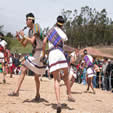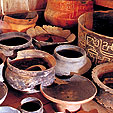|
Tourism and Development in Ecuador
 |
Ecuador is a country with endless
natural richness. The geographic and climatic diversity of its four
regions have given rise to thousands of unique species of flora
and fauna. All in all, Ecuador is home to at least 4,500 species
of butterflies, 345 reptile species, 358 species of amphibians,
and 258 mammal species, among others, many of which are located
in the 26 protected areas along the Country. Teeming with so much
life, it is no wonder that Ecuador is one of the planet’s top
17 nations with more biodiversity. Moreover, Ecuador is not only
diverse with respect to its wildlife.
The nation is also home to 13 indigenous nationalities, each of
which maintain their traditional customs, way of life, and world
vision. The Eastern Quichua, Huaorani, Achuar, Shuar, Cofan, Siona-Secoya,
Shiwiar, and Zaparo all live in the Amazon region. In the Andes,
live the highland Quichua such as the Cañaris and the Saraguros.
The Coastal region is home to the AWA, Chachis, Cayapas, Tsachilas,
and Huancavilcas. The urban areas are inhabited mainly by mestizos
(mixed race), whites, and Afro-Ecuadorians.
 |
Ecuador’s official language
is Spanish, but a variety of indigenous languages, such as Quichua,
Awapit, Cha’palachi, Tsafiqui, Paicoca, A’ingae, Huatirio,
Shuar-chichan, and Zaparo are still spoken widely in rural areas.
Using the area’s natural resources to produce some of the world’s
finest artisan crafts, Ecuador’s indigenous groups handcraft
hats, woven goods, wood carvings, and much more. In addition to
providing income to these marginalized groups, the production of
these crafts help the groups that make them maintain their culture,
life, religion, myths, and fantasies while sharing their beauty
with the world. The Ecuadorian Andes region is famous worldwide
for its prolific production of fine leather products. In the Austro
of the southern highlands, fine silver and gold works abound. In
the coastal and Amazon regions, pottery-making and straw-weaving
are part of everyday life. Throughout Ecuador, men and women alike
are skilled at giving shape to clay and vegetable fibers.
Ecuador’s strategic location has brought many twenty-first
century investors and businessmen to the country. Located in the
middle of the world, it opens its doors to commercial and cultural
exchanges, alike. Ecuador is the world’s largest banana producer
and one of its main flower exporters. Tourism is the country’s
fourth largest income-earner, with oil being its number one revenue
generating industry. Shrimp and cocoa are also of great importance
to the nation’s economy, which now has the U.S. dollar as its
official currency. With well-developed tourist infrastructures,
Ecuador’s major cities offer all types of services from fine
dining to lodging in the world’s most luxurious hotel chains.
Quito is the political heart of the nation, Guayaquil is the country’s
economic pulse, Manta is an important port and tourist destination,
and Cuenca is the cultural center of Ecuador.
TOP
|

